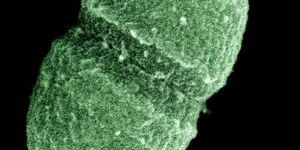Dietary Selenium May Fight Acute Myeloid Leukemia
Diets that contain high levels of the nutrient selenium may help stave off myeloid leukemia, suggests new research published in Cell Reports. Selenium is a trace mineral that can be found in many types of foods. Some of the highest levels are found in Brazil nuts, halibut, sardines, beef, chicken, rice, eggs, baked beans, and lentils, for some examples. Acute myeloid leukemia (AML) is the most common type of blood and bone marrow cancer in adults, and these findings may help scientists develop better therapeutics for various types of leukemia, including AML.
Previous work performed in a mouse model showed that selenium supplements can trigger the production of molecules called cyclopentenone prostaglandins (CyPGs), which seem to suppress or destroy leukemia stem cells. In this work, the researchers showed that CyPGs can bind to a gene called GPR44. This gene encodes for a type of membrane receptor called a GPCR or G-protein-coupled receptor, which responds to extracellular signals. When GPR44 is expressed in leukemia stem cells and sits in their membrane, it will instruct the cells to go through a programmed cell death pathway, eliminating them.
"The GPR44 receptor is not well understood," said study co-author Robert Paulson, professor of veterinary and biomedical sciences at Penn State's College of Agricultural Sciences. While GPR44 is thought to aid the functions of some immune cells, and is involved in type two immune response regulation, this work outlines a previously unknown role for GPR44.
"We came from the prostaglandin side—that the prostaglandin seemed to be able to induce cell death in leukemia stem cells. And now we've shown that it works through GPR44," added Paulson.
In AML, abnormal stem cells in blood, bone marrow and other tissues begin to grow. These stem cells make treatment challenging, and most therapies don't target them. "As a result, relapse of the disease is a big concern," said lead study author Sandeep Prabhu, professor of immunology and molecular toxicology and head of the Department of Veterinary and Biomedical Sciences at Penn State.
In this study, the investigators harvested abnormal stem cells that cause leukemia from a mouse model that lacked GPR44. These stem cells were transplanted into mice that carried GPR44. Some of these mice has also been given selenium supplements before the transplant.
When GPR44 was gone, the selenium supplements did not work as well; the success of the selenium treatment seemed to rely on the presence of GPR44. "In mice that lack the receptor, the leukemia becomes extremely aggressive; it's like taking the brakes away," Prabhu said.
Previous work has shown that selenium supplements or CyPG treatment can slow leukemia progression or even cure it in a mouse model, noted Paulson. CyPGs can cause death in leukemia-inducing stem cells, while leaving healthy bone marrow stem cells alone. Thus, this could be a safe therapeutic that removes leukemia cells without causing harm.
GPR44 expression in leukemia cells might also act as a biomarker for leukemia aggressiveness of leukemia and may indicate which patients would benefit from certain therapies.
More research will be needed, but the scientists are working towards clinical trials with leukemia patients to test the efficacy of this approach in humans.
Sources: Pennsylvania State University, Cell Reports









